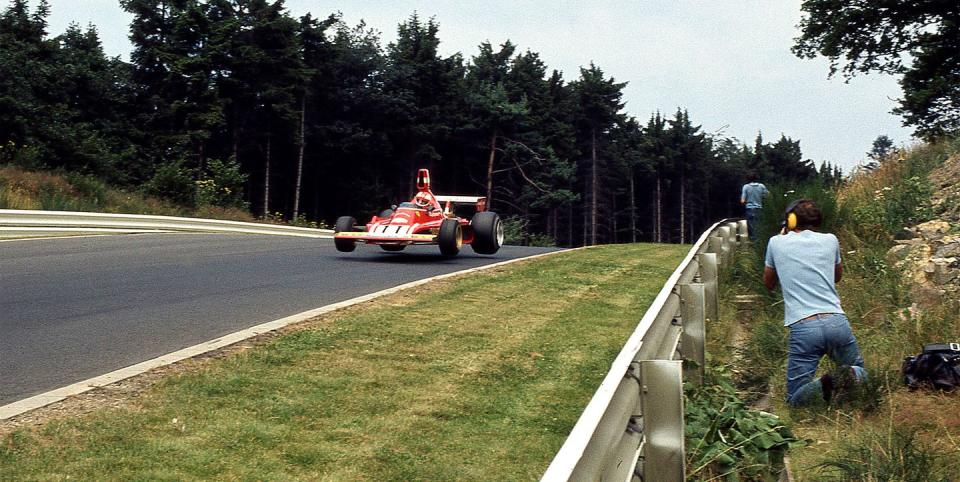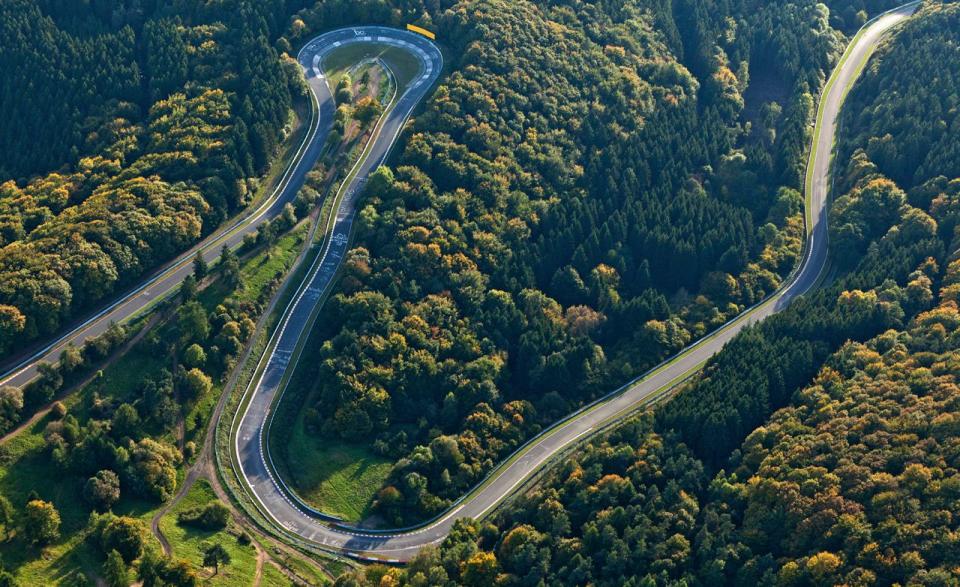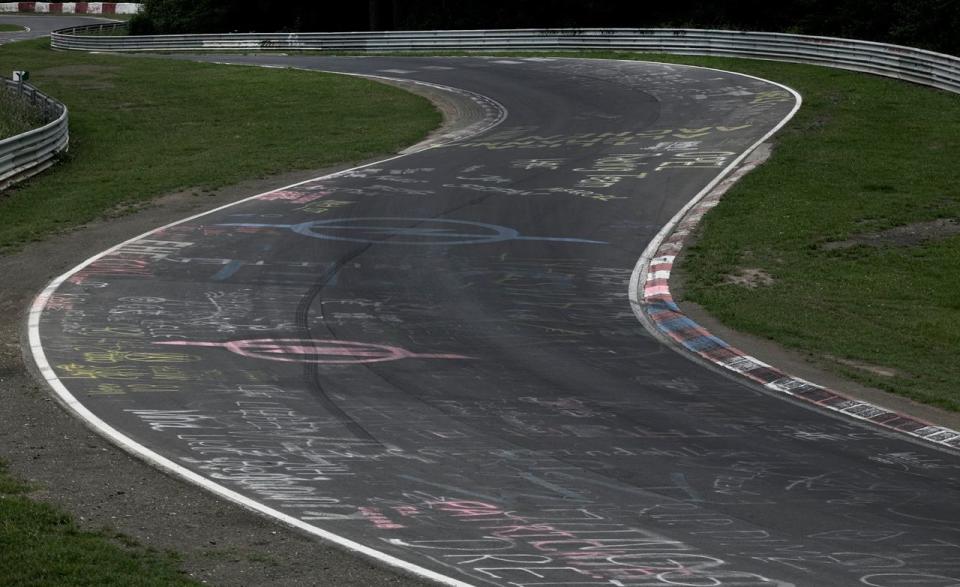Why the Nürburgring Is Perfect for Vehicle Development

Germany’s Nürburgring circuit is archaic, narrow, and surrounded by unforgiving trees. The Nordschleife (or “North Loop”) snakes through the Eifel mountains and is long enough, at 12.9 miles, that sunny weather on one part of the course doesn’t mean it isn’t snowing somewhere else on the track.
Cenek Junek, a 34-year-old Czech banker with some talent and racing dreams, crashed his Bugatti Type 35B during the 1928 German Grand Prix, becoming the first driver to die there. Dozens have since met the same fate during races, testing, and public days. Niki Lauda was virtually incinerated during the 1976 German Grand Prix partly because rescue personnel needed so much time to reach his Ferrari 312T2 as it burned at Bergwerk, a corner halfway around the track. After that, Formula 1 would never return to the place Jackie Stewart dubbed the “Green Hell.”
Now, 90 years after its 1927 opening, the Nordschleife has become the most prominent vehicle-development test track on earth. Lap times on it are the de facto standards by which every serious sports, performance, and exotic car is judged.

The core of what has revived the Nordschleife is the establishment of the Industry Pool, which brings together carmakers and suppliers from around the world to co-rent the track for 16 weeks of the year to develop and tune new products. During Industry Pool weeks, there can be a dozen or more manufacturers testing prototypes on the Nordschleife, tweaking their products’ handling and guaranteeing YouTube stardom.
The engineers and drivers who use the Nordschleife to develop their vehicles tell us what makes the track special:
█ Mark Stielow, engineering group manager of vehicle dynamics, General Motors: Most projects get two trips to the ’Ring. There’s one fairly early in the development cycle. We call it an IVer phase-integration and verification phase. Then later on, it depends on when the vehicle is launching and when SORP [start of regular production] is, and when different milestones are. An early look-see and a final time to put the final touches on the car.
█ Ted Klaus, NSX lead engineer, Honda R&D Americas: Driving that course is breathtaking. It’s one of those acid tests, like many courses, perhaps the biggest mental acid test I’ve ever had in my life. Even a driver that’s pretty comfortable pushing a car hard has his or her brain screaming at them that what you’re doing and what you’re seeing is incongruous with the speed combined with the lateral g’s. Imagine using that environment to make the man/machine connection more trustworthy.
█ Kevin Zelenka, senior ride and handling engineer, General Motors: That’s the beauty of the Nürburgring. It’s 12.9 miles around, and because of the configuration of the track-the elevation changes, the tight turns, and the long straightaways-you can look at everything.
█ Matt Becker, chief of vehicle attribute engineering, Aston Martin: There is a gentlemen’s agreement that you go out on-track whenever you want throughout the day and just get on and do your testing. We never look at or study other Industry Pool vehicles, as we all respect each other’s confidentiality.
█ Nick Robinson, vehicle dynamics engineer, Honda R&D Americas: We’ll probably spend 75 or 80 percent of our time on the roads and autobahns around there. And then check that work on the Nordschleife. And so will the other manufacturers.
█ Stielow (GM): There are certain manufacturers and certain drivers that, over time, you recognize and learn you can trust. They’ll keep their line, and you can run a little bit more of a racing line with them. There are other manufacturers that I’ll give a wider berth.
█ Robinson (H): I can’t say I’m on a first-name basis with a lot of the other drivers there. But over the years, you visually get to know people. There’s a lot of professional respect for making clean passes. And there are only so many places to eat dinner.

█ Bill Wise, Camaro performance engineer, General Motors: It kind of fell to me to drive [the ZL1 1LE] by default. I don’t want to say that like it’s a bad thing. It was a mixture of comfort level in the car and maybe a little bit of a reward for a year and a half of work. That’s the fastest lap we have video of, but it’s not the fastest lap we ran while we were there. I did a 7:15 from a dead stop. If we take out the dead stop, which is about two and a half to three seconds, on the last day, we essentially ran a 7:13. But that was during [Industry] Pool, so we weren’t allowed to run video. We posted the fastest one we can back up with video.
█ Becker (AM): We wouldn’t compromise the feel or behavior of an Aston Martin product to achieve a lap time. Lap times are important, especially on the sports cars more than the GTs, but we don’t chase the numbers. But we want to be competitive in the relevant segment.
█ Stielow (GM): Normally, we use the ride and handling engineer [to extract the fast lap]. They’ve been with that property since day one, and they know more about that vehicle than anyone else on the face of the planet. You’re not going to be a level-six Nürburgring driver [GM’s top driving level reserved for engineers who set lap times] if you’re not a little bit aggressive.
█ Robinson (H): I really like to share that place with some of the younger engineers that we have here. Those first couple of laps to show the course to someone who grew up playing Forza or Gran Turismo to get a feel for the course, it’s still jaw-dropping for those guys. To actually be there and see the elevation change, the narrowness of the course-there are so many blind sections where you’re holding the throttle open. It’s kind of a sensory overload, as you’re just starting to understand the course.
█ Wise (GM): You have some moments where you kind of pucker and go, “Oh crap, that wasn’t good.” But there were no times for me when I was afraid of anything. When we’re doing development, I definitely have the engineer hat on, and I’m looking at the car analytically. But when you do a fast lap, it’s like flipping a switch from development side to racing side. It’s a track that rewards taking risks. So there comes a time when you get yourself into a situation you may not be comfortable with, just to see what the car will do. And then, on a lot of occasions, the car will stick.
█ Becker (AM): The circuit is incredibly useful for highlighting any stability issues.
█ Robinson (H): The unique thing about the ’Ring is that the road, in certain places, violently tries to throw your car away from the road right where you need to stay attached to the road.
█ Wise (GM): The vertical changes are so severe and so abrupt that you need the right damping levels to control those body motions and get the most out of it. We’ve got two functions: Flying Car PTM [Performance Traction Management, a stability-control algorithm that recognizes the vehicle is airborne and keeps the electronics from freaking out despite the complete lack of traction] and Flying Car ABS. In most of those scenarios, when the vehicle is airborne, it sees massive wheelslip and brings in a big torque reduction. So it’s really slow when it lands. We basically time it out so it doesn’t do that. And it’s the same on the ABS side.
█ Zelenka (GM): Flying-car algorithms. That specifically came from pucker moments at the Nürburgring where, “Oh shit, we’ve got to do something to fix this [when the electronics improperly respond to all the wheels leaving the ground by cutting power or applying the brakes].”
█ Klaus (H): The active-damper-system logic originally introduced on the ’07 MDX was significantly modified by the challenges of the ’Ring.
█ Zelenka (GM): One of the difficulties with the track is that, if you find something in a specific corner, like you lose steering assist at the bottom of Fuchsröhre and you make a calibration change, it’s at least eight minutes around before you can take a look at that [calibration] change again.
█ Robinson (H): We did one of our big powertrain trips for two weeks. We had maybe 20 guys. Other times, we’re down to 12 or so.
█ Zelenka (GM): We’ve had as many as 24 to 25 engineers and supplier engineers [at the ’Ring] when we sent Cadillac, Camaro, and Corvette out there. When the execu-types show up, it’s up to 36 people. If we’re strictly going there to do a fast lap, it’s fewer people. Our teams generally prefer [to stay at] the family-owned places. They treat us like family. And pack us lunches. They email me Christmas cards.
█ Klaus (H): One of the first times we went there, we stayed at a hotel in Müllenbach, and for breakfast, each table was set up with a little flag. Either the [manufacturer’s] national flag or Volkswagen, Audi, Porsche [brand flags] . . . and we came down, and there was a little Honda flag. It was pretty cool.
You Might Also Like

 Yahoo Autos
Yahoo Autos 